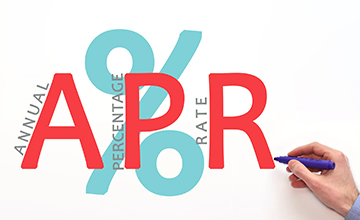Understanding APR and Its Impact on Loan Costs

Navigating loans can feel like going through many complicated terminology and surprise fees. One term that gets widely discussed but often misunderstood is APR or Annual Percentage Rate. Knowing what APR means is about more than just getting financially literate. It’s a must-have skill for anyone considering borrowing money, whether for a house, car, or personal loan.
This article will decode the confusion around APR so that readers understand what it is and how it impacts loan costs. By breaking down APR and showing how it gets calculated, people can make smarter choices about loans that line up with their money goals without racking up extra expenses by accident.
Table of Contents
- What is APR?
- How is APR Calculated?
- What Factors Affect APR?
- How Does APR Impact Loan Costs?
- How to Get a Lower APR?
- Bottom Line
What is APR?
According to the Military Lending Act, the Annual percentage rate (APR) shows how much it costs to borrow every year after adding the interest and fees. It’s meant to help people compare different loans and credit cards to see which is more affordable.
The idea behind APR is that people can use it to make smarter choices about loans or credit cards, depending on their situation. Suppose you’re deciding between one card with a lower interest rate but higher fees and another with a higher rate but lower fees. The APR would show you which one costs less overall. Then, you could pick the one that saves you more money over time.
What Are the Different Types of APR?
APR, or Annual Percentage Rate, tells you how much interest you’ll pay over a year for a loan or credit card. Here are some types you might see:
Fixed APR sticks around for the whole loan. Your monthly payments stay the same, so it’s predictable. Variable APR goes up and down depending on interest rates. Your payments change, too, so budgeting can be tricky, but it might start lower with a variable APR. Introductory APR is a unique rate credit card offered to you by credit card issuers at first to get you signed up. Purchase APR is the interest rate applied to the purchase you’ve made with your credit card. A purchase APR is set by credit card companies. Cash Advance APR: Taking cash out from a credit card will cost you way more in interest than just buying stuff. The annual percentage rates on advances are sky-high compared to everyday purchases. They start charging you interest immediately instead of having a grace period. Plus, they might tack on fees just for taking the advance out. Balance Transfer APR: When you make balance transfers, what you owe from one card to a new card, that new card could give you a lower rate. It depends on the terms. But that intro balance transfer APR isn’t going to last forever. Ensure you check what the regular rate will be after the promo ends. You want to avoid getting stuck paying a super high rate down the road just cause you transferred over some debt. Penalty APR is charged when you default on your credit card payments. Then, the credit card APR rises.
How is APR Calculated?
First, you have to look at the loan’s interest rate; that’s the percentage of the loan the lender charges you for borrowing their money. Then, tack on any fees for originating or processing the loan. Remember, closing costs, too, and any cost associated with getting the loan goes into cooking up the APR.
Calculating APR can be confusing, but breaking it down step-by-step makes it easier. Start by dividing the total interest and fees by the loan amount you initially took. It gives you a percentage representing how much extra you pay back compared to the borrowed money.
Next, you’ll want to divide that percentage by the number of days in your repayment schedule. That transforms it into a daily rate. After that, multiply it by 365 since there are that many days in a year typically. And finally, multiply the whole thing by 100 so you have an excellent complete percentage. It involves a bit of math, but breaking it down step-by-step makes it less intimidating. The most important thing is knowing precisely how much extra you’ll owe in interest based on the terms.
How Does APR Compare to Other Loan Terms?
The APR is a significant number to look at when comparing loan options, but it doesn’t tell the whole story. Here’s how APR stacks up to other parts of a loan:
Interest Rate. It is the cost of borrowing money shown as a percent of the total loan amount. It includes other expenses like origination fees, discount points, and closing costs. So, the interest rate is the basic charge, but the APR is the total cost of the loan. Fees and Charges. It can be application fees, origination fees, processing fees, or any other costs the lender charges. Loan Term. The loan term is the timeframe for your loan repayment. It may vary between 14 days and several years or more. Nominal Interest Rate. The interest rate the bank tells you is called the nominal rate. But that doesn’t include the extra fees they might charge. APR shows the actual cost better since it adds in those fees.
What Factors Affect APR?
A few things can impact the APR on a loan or credit product. The main factors are:
Credit Score. One significant factor is the person’s credit score. Lenders use scores to determine the risk of lending money, and people with higher scores typically get lower APRs since they’re seen as less risky. Economy. Things like interest rates from the Federal Reserve, inflation, and market trends affect APR too. When rates are low, lenders provide lower APRs to attract borrowers. However, APRs often go up in shaky economies or when inflation is high. Loan Length. Shorter loans usually have lower APRs compared to long-term loans. That’s because the risk for lenders is lower over shorter periods. Loan Amount. The sum borrowed can impact APR, too. Sometimes lenders offer lower rates for bigger loans, while smaller loans have higher APRs. Loan Type. Different loans like mortgages, personal loans, car loans, and credit cards have varying risk levels and APR structures. Secured loans often get lower rates versus unsecured loans. This happens because secured loans are backed with collateral, which decreases the lender’s risk; meanwhile, an unsecured loan doesn’t require any asset.
What Are the Risks of a High APR?
High APRs can put borrowers in a tough spot. You get smacked with higher interest costs on whatever you still owe, so your total payments balloon over the life of the loan or credit card’s APR. According to the International Monetary Fund, it can strain your budget when the monthly bills get jacked up, making it hard to stay on top of your other money.
More of your cash goes to interest instead of paying down what you borrowed, so you stay stuck in debt way longer, dragging out the pain. You miss some inflated payments, and your credit score takes a punch. Plus, lenders may not want to give you any more loans or credit since your APRs are so high already, and so high APRs can hit you from all angles: more enormous bills, budget squeezed, debt hanging on forever, credit drop, no new money when you need it.

How Does APR Impact Loan Costs?
APR is essential in figuring out how much a loan will cost someone. It impacts the total cost in the following key ways:
Improving your credit score is like unlocking a treasure chest of financial possibilities and securing better loan terms. Dive into these steps to boost your credit and set yourself up for brighter financial horizons:
It includes the interest rate charged on the loan amount over a year. So, a higher APR means the person will pay more interest charges over time, raising the total cost of the loan. The APR also covers any extra fees and costs tied to the loan, like origination fees, closing costs, or points. Adding in all these fees can make the loan much more expensive. The annual rate also lets you easily compare the actual cost of loans from different lenders. Since it combines rates and fees into one standard number, borrowers can use it to make smarter choices about which loan works best for their situation. APR assumes you’ll pay off the loan over the entire repayment period. So, shorter-term loans will tend to have a higher APR, while longer-term loans will tend to have a lower one, even if the base interest rate is the same. It shows how the total cost changes depending on how long you take to repay it.
How to Get a Lower APR?
Getting a lower yearly interest rate on loans and credit cards can help you save a lot of cash over time. If you want to pay less interest on a loan you already got or get a good deal on a new credit card, you must know what makes the rates go up or down, and then you can try to get the percentage down and stop giving so much money to the banks.
What are Some Tips for Getting a Lower APR?
Lower interest rates suit your wallet and can make managing money less painful. Here are some tips for getting better rates on loans and credit cards:
Having good credit helps. Paying bills on time and less debt can improve your score, so you qualify for lower rates. Ask your current lenders if they can reduce your rates since you pay on time. Compare rates from different places. You may find better deals, especially introductory offers, by shopping around. Transferring balances from high-rate cards to lower-rate ones saves money, but watch out for fees. Most importantly, reducing debt improves your credit and options for better rates. Consider applying with a creditworthy co-signer if your credit history is limited. Cosigner’s good credit could help you qualify for better terms. Think about putting up collateral like a savings account to back the loan. That lowers the lender’s risk. Setting up automatic payments shows responsibility and timely payments. Some lenders reward that with better rates.
Bottom Line
Understanding the annual percentage rate (APR) is super important for anyone taking out loans or using credit cards. It’s not just about being financially literate. You must understand the APR to navigate the tricky world of borrowing money and avoid extra costs.
We explained what APR is, how it’s calculated, different types of rates, and what makes it go up or down. By wrapping your head around APR, you can make way more informed choices when getting loans and decide whether it works for your money plans.
APR is clutch cause it shows both interest rates and fees for loans and cards, and it lets you easily compare different options and pick the most affordable one for your sitch. And since APR impacts how much loans cost you, securing a lower rate is vital to keeping interest payments and financial stress lower.
Resources:
